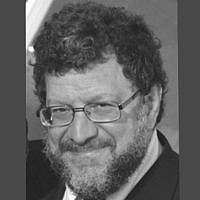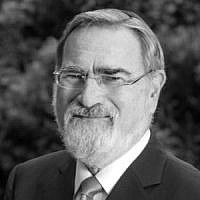‘Assembly’ Parashat Tzav – Parah 5784
The Tabernacle (Mishkan) is complete and now the Priests (Kohanim) must undergo a course in Mishkan Administration (MA). The course would be overseen by none other than Moshe. The coursework includes donning and removing the priestly garments, anointment with oil, and the offering of an assortment of sacrifices and sprinkling of their blood. Simultaneously, Moshe would assemble and disassemble[1] the Mishkan. This regimen was to be repeated for seven consecutive days, known as the “Seven Days of Consecration (Milu’im)”. On the eighth day, the grand opening ceremony for the Mishkan would be held and, if all went right, the Divine Presence would descend from heaven and manifest itself in the Mishkan.
When G-d first commands Moshe regarding the Mishkan Administration Program, He tells him [Vayikra 8:3] “Assemble the entire congregation (edah) at the entrance of the Tent of Meeting”. Moshe does precisely as he is commanded [Vayikra 8:4]: “The congregation assembled at the entrance of the Tent of Meeting”. Rashi[2] notes that for a congregation that numbered six-hundred thousand men between the ages of twenty and sixty, along with a similar number of women and children, to assemble itself in front of a tent that measured only thirty cubits by ten cubits, some serious miracles had to take place. Rashi sums things up: “This is one of the instances where a small [area] accommodated a large [number of people]”. That’s for sure. Rashi’s source is the Midrash Vayikra Rabbah [10:9]. In order to continue, we must take a closer look at this Midrash. The Midrash brings seven examples of instances in which a small object behaved like something much larger:
- During the seven days of creation, all the waters of the world contract [Bereishit 1:9] “into one place” to reveal dry land.
- In the plague of boils, Moshe and Aaron each throw a handful of soot skywards [Shemot 9:8] and the entire Land of Egypt is covered.
- The entire nation of Israel assembles in the courtyard of the Mishkan, which measured one hundred by fifty cubits [Shemot 27:18].
- The entire nation of Israel assembles in front of a rock that was going to provide water [Bemidbar 20:10].
- Joshua assembles the entire nation of Israel between the two poles of the Ark of the Covenant [Joshua 3:9].
- In the courtyard of the Holy Temple (Beit HaMikdash), people would stand crowded but prostrate themselves spaced [Avot 5:5].
Rashi’s miraculous Mishkan is only one way of understanding the verse. The Ibn Ezra[3] interprets the verse very differently. According to the Ibn Ezra, Moshe assembled only the tribal leaders and the elders. These people could all easily have stood together at the entrance of the Tent of Meeting without any miraculous intervention. The Malbim[4], in a similar vein, explains that the “edah” is the High Court (Sanhedrin) of seventy elders, again, eliminating the requirement for a miracle. Why does Rashi, who professes to always use the simple meaning of the verse, take the more complicated miraculous route? Further, if Rashi continues down the path of “edah” equals “the entire nation”, he will eventually run into a brick wall. When Korach rebels against Moshe’s leadership, he stages a mass protest [Bemidbar 16:19]: “Korach assembled all the congregation (edah) against [Moshe and Aaron] at the entrance to the Tent of Meeting, and the Glory of G-d appeared before the entire congregation (edah)”. Does Rashi maintain that Korach also performed a miracle by gathering the entire nation in front of the Tent of Meeting? Here Rashi is silent and for good reason. The Torah repeatedly refers to Korach’s mutinous co-conspirators as [16:5] an “edah”, such that when the Torah refers to Korach assembling the “edah” in front of the Tent of Meeting, it is more than likely referring to Korach and his band of a few hundred merry men, eliminating the need for miraculous intervention. Why, then, does Rashi insist that the entire nation had to be assembled at the entrance of the Mishkan during the Seven Days of Consecration?
These questions are asked by Rabbi Asher Wasserteil[5] in his commentary “Birkat Asher”. Rabbi Wasserteil proposes an answer based upon a comment made by several medieval commentators that G-d wanted to show the entire nation that Moshe’s choice of his brother, Aaron, and his children to officiate at the Mishkan was not a case of nepotism, but, rather, was explicitly mandated by G-d[6]. It was vital to prove this point not only to the elders but also to the entire nation, requiring that they all be present when the Kohanim were ordained.
The explanation of Rabbi Wasserteil opens a whole new can of worms. The “Seven Days of Consecration” was a dry run for what would happen on opening day. Would it not have been sufficient to squeeze the entire nation into an impossibly small area only on the day the Mishkan opened for business, when G-d’s Divine Presence would enter the Mishkan, proving unequivocally that the Kohanim that were officiating in the Mishkan were doing so at the express written consent of G-d? Why perform the same miracle seven times in preseason games? Why not just wait for the regular season?
To answer this question, we must return to the Midrash from which Rashi takes his “small accommodating the large” comment. There is a common denominator in all the seven examples brought in the Midrash other than the last one. In all these instances, the miraculous contraction is a precondition for another miracle: the creation of dry land, a rock gushing enough water to quench the thirst of a nation, an unprecedented pandemic, and, in three instances, the revelation of the Divine Presence. In all these instances, a smaller miracle needed to take place to pave the way for a greater one.
With this in mind, let us now take another look at the “Seven Days of Consecration”. What was the purpose of the dry run? Did the Kohanim really need to practice getting in and out of their priestly garb? Did Moshe really need to get the hang of putting together and taking apart the Mishkan? The Talmud tells us countless times that “Kohanim are careful (zerizim)”, meaning they are careful and quick to observe their duties and there is no fear of laziness and forgetfulness on their part. Just show it to them once and they’ll figure it out. I suggest that the “Seven Days of Consecration” were required not for the Kohanim, but, rather, for the rest of the nation. They needed to be able to entertain the possibility of a miracle, that an Infinite G-d could miraculously contract His Divine Presence into a finite world. The way to demonstrate this possibility was by having them repeatedly experience a similar miracle but on a smaller scale. For seven days, they would break the laws of physics until they began to realize that the same G-d Who had created those laws could break them at will. What occurred during the “Seven Days of Consecration” was only a headline. The real story was the act of assembling “the entire congregation” at the entrance of the Tent of Meeting. If they could transcend their own selves, then, perhaps, so could G-d.
Ari Sacher, Moreshet, 5784
Please daven for a Refu’a Shelema for Sheindel Devorah bat Rina, Rina bat Hassida, and Esther Sharon bat Chana Raizel
[1] This is not explicitly mentioned in the Torah. It is mentioned by our Sages in the Midrash [Sifrei Bemidbar 44]. The Midrash also asserts that Moshe assembled and disassembled the Mishkan all by himself.
[2] Rabbi Shlomo Yitzchaki, known by his acronym “Rashi,” was the most eminent of the medieval commentators. He lived in northern France in the 11th century.
[3] Rabbi Abraham Ibn Ezra, usually referred to as “The Ibn Ezra”, lived in Cordoba, Spain, at the turn of the 12th century.
[4] Meir Leibush ben Yehiel Michel Wisser, known by his acronym “Malbim”, lived in Poland in the 19th century.
[5] Rabbi Wasserteil lived in Jerusalem in the previous century.
[6] The Chizkuni explains similarly that G-d wanted the entire nation to watch so that they would treat the kohanim with respect.



